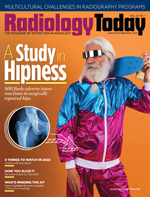 Ultrasound News: Thinking Cap
Ultrasound News: Thinking Cap
By Keith Loria
Radiology Today
Vol. 23 No. 1 P. 26
Researchers are working on a wearable head scanner to enable photoacoustic imaging.
Historically, imaging of the adult human brain has primarily been conducted with MRI, which is excellent in penetration depth and soft tissue contrast but suffers from a low imaging speed and high cost. There has long been a strong demand for faster brain imaging technology. Researchers in the Penn State College of Engineering believe that this demand will be met with proposed technology that aims to facilitate brain disease diagnoses by providing real-time, high-resolution functional imaging that is not achievable by other imaging modalities.
The researchers have proposed creating a wearable head scanner that can clearly visualize and accurately assess the brain via a photoacoustic imaging device embedded in a stretchable, flexible material. Photoacoustic imaging generates ultrasonic waves with a pulsed laser and reconstructs the image of light energy absorption distribution in the tissue.
The team is led by Yun Jing, PhD, the principal investigator and an associate professor of acoustics and biomedical engineering at Penn State University, and Huanyu “Larry” Cheng, PhD, an assistant professor of engineering science and mechanics at Penn State. Thanks to a two-year, approximately $900,000 grant from the National Institutes of Health’s BRAIN Initiative, the research team plans to build a prototype of the wearable scanner to advance the diagnosis and treatment of neurological issues through accessible testing.
Challenging Parameters
Jing had been working on transcranial ultrasound for more than 10 years and was aware of the fact that a major brain imaging challenge lies in sending ultrasound waves through the skull. “After I moved to Penn State last year, I was ecstatic to find out that Dr. Cheng was working on soft electronics,” he explains. “After some discussion, it became clear to us that we could collaborate on this idea of developing a stretchable array for improving brain imaging using photoacoustics.” Because photoacoustic imaging is similar to ultrasound imaging, in that both can be propagated with relatively portable devices, the research team knew it would be less expensive than MRI, while also avoiding the radiation associated with CT scans.
Junjie Yao, PhD, an assistant professor of biomedical engineering at Duke University, who was part of the team, had been working on photoacoustic imaging for more than a decade. “Although it is always promising for adult human brain imaging, it has never been achieved, due to the exceeding difficulty of getting the ultrasound waves out of the brain with the bone intact,” Yao says. “The skull distorts and attenuates the ultrasound signals, making the signals practically useless when reconstructing the photoacoustic images. The team has been working together for years to find a solution and making baby steps toward a breakthrough idea.”
Creating a working helmet scanner is not easy. For one, Jing notes, it’s extremely difficult to locate each sensor after the array is stretched. “We have several possible solutions in mind and will test them in this [National Institutes of Health]–funded project,” he says.
But that’s just the beginning. Yao says another challenge is the number of ultrasound transducer elements that can be assembled into the helmet, which eventually determines the spatial resolution and field of view of the imaging.
Then there’s the accuracy of the computational model that can correct for the skull’s aberration and distortion of the ultrasound signals, as well as the light delivery into the brain through the skin and skull to generate sufficient photoacoustic signals of the brain’s hemodynamics. “The key component is the flexible ultrasound detector array that can be flexibly mounted to the patient’s head,” Jing says. “Several other innovations include computational model transcranial photoacoustic imaging reconstruction, local light excitation with high delivery efficiency and safety, and an optical tracking method to map the helmet’s location and dimension.”
A View of the Future
As of early December 2021, the researchers were working on a proof-of-concept study. “We plan to demonstrate a 256-element stretchable array and test it using ex vivo human skulls and brain phantoms,” Jing says. “If successful, we will apply for more funding to develop a larger array that can truly be used as a helmet.”
The goal is to develop the prototype systems during the two-year grant period and then validate it on head-mimicking phantoms for technical iteration. A larger array (full helmet) will probably take an additional three to four years to make and test.
Once a prototype is ready, Yao and Wuwei Feng, MD, MS, division chief of stroke and vascular neurology and a professor of neurology at the Duke University School of Medicine, will test its function and capabilities. “We believe the stretchable ultrasound array coupled with novel local light illumination and the advanced transcranial computational tool will do the magic,” Yao says.
In the clinical setting, Jing hopes that the helmet will one day be used to do functional imaging of freely behaving humans for behavioral testing—similar to the use of functional MRI but much cheaper—and detecting intracranial hemorrhage.
“This is a longshot goal. The technology is clinically promising and significant. The major task is to demonstrate its effectiveness and safety before the translation,” Jing says. “We hope to understand better the brain’s hemodynamic impairment in diseases and restoration in treatment. We also expect to apply this technology for fundamental brain research, such as decoding brain activity during dreams and language use.”
— Keith Loria is a freelance writer based in Oakton, Virginia. He is a frequent contributor to Radiology Today.

